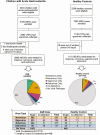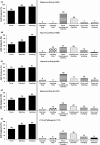The Changing Landscape of Pediatric Viral Enteropathogens in the Post-Rotavirus Vaccine Era
- PMID: 32009161
- PMCID: PMC7884803
- DOI: 10.1093/cid/ciaa100
The Changing Landscape of Pediatric Viral Enteropathogens in the Post-Rotavirus Vaccine Era
Abstract
Background: Acute gastroenteritis (AGE) is a common reason for children to receive medical care. However, the viral etiology of AGE illness is not well described in the post-rotavirus vaccine era, particularly in the outpatient (OP) setting.
Methods: Between 2012 and 2015, children 15 days through 17 years old presenting to Vanderbilt Children's Hospital, Nashville, Tennessee, with AGE were enrolled prospectively from the inpatient, emergency department, and OP settings, and stool specimens were collected. Healthy controls (HCs) were enrolled and frequency matched for period, age group, race, and ethnicity. Stool specimens were tested by means of reverse-transcription real-time quantitative polymerase chain reaction for norovirus, sapovirus, and astrovirus RNA and by Rotaclone enzyme immunoassay for rotavirus antigen, followed by polymerase chain reaction verification of antigen detection.
Results: A total of 3705 AGE case patients and 1563 HCs were enrolled, among whom 2885 case patients (78%) and 1110 HCs (71%) provided stool specimens that were tested. All 4 viruses were more frequently detected in AGE case patients than in HCs (norovirus, 22% vs 8%, respectively; rotavirus, 10% vs 1%; sapovirus, 10% vs 5%; and astrovirus, 5% vs 2%; P < .001 for each virus). In the OP setting, rates of AGE due to norovirus were higher than rate for the other 3 viruses. Children <5 years old had higher OP AGE rates than older children for all viruses.
Conclusions: Norovirus remains the most common virus detected in all settings, occurring nearly twice as frequently as the next most common pathogens, sapovirus and rotavirus. Combined, norovirus, sapovirus, rotavirus, and astrovirus were associated with almost half of all AGE visits and therefore are an important reason for children to receive medical care.
Keywords: acute gastroenteritis; healthy controls; outpatient; rotavirus; viral detection.
© The Author(s) 2020. Published by Oxford University Press for the Infectious Diseases Society of America. All rights reserved. For permissions, e-mail: journals.permissions@oup.com.
Figures





References
-
- Kim HS, Rotundo L, Nasereddin T, et al. . Time trends and predictors of acute gastroenteritis in the United States: results from National Health and Nutrition Examination Survey 2005–2014. J Clin Gastroenterol 2017; 51:693–700. - PubMed
Publication types
MeSH terms
Substances
Grants and funding
LinkOut - more resources
Full Text Sources
Medical
Miscellaneous

